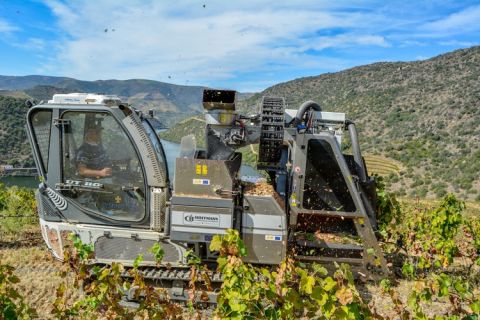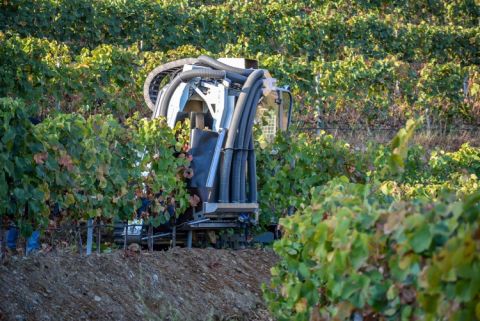Further below, Sophia Bergqvist, owner of Quinta de la Rosa, adds her perspective on 2019.
Viticultural challenges in the Douro
It is easy for visitors to the Douro to assume that ours is a region where change happens slowly, if at all. We produce wines in an area of outstanding beauty, with hillsides sculpted by stone terraces built many generations ago and unforgiving vineyards still mainly harvested by hand. However, a closer look shows a region experiencing accelerating rates of change across all dimensions – social, economic, viticultural and environmental. The 2019 harvest marks another milestone in our region’s transition into a new era – both challenging and exciting in equal measure.
The Douro has been experiencing a declining population for over 15 years, with young people understandably looking beyond the extremely demanding job of a grape farmer to alternative career paths. As a result of this – and the welcome Portuguese tourism boom that is providing good employment opportunities – it has been increasingly difficult to find seasonal workers at harvest time. Unlike easily mechanisable vineyards in other wine regions, the Douro has over 42,000 ha [103,785 acres] of mountain vineyard (representing 52% of the global total). We face a considerable challenge if there aren’t enough people to bring the grapes into the winery at harvest time. The two previous vintages saw shortfalls in terms of yields, however 2019 was a bigger year, more in line with the average, and many properties had trouble finding enough people to pick.
At Symington we employ many people during the vintage and will continue to do so. We have over 1,000 ha of prime Douro vineyard, much of it on narrow stone terraces with steep inclines that can only be harvested by hand. Nevertheless, in anticipation of the worker shortfall, for the past seven years we have been pioneering the development of a mechanical harvester designed for mountain vineyards. The 2019 harvest was the 4th year of trials with the Symington-Hoffmann harvester (above and below), which performed well on terraces at several of our quintas and largely exceeded expectations. There are still challenges to overcome, including adapting some of our vineyards to accommodate the harvester. Nevertheless, I believe we have a viable solution for one of the big issues confronting the future of our region. Clearly the labour challenge needs addressing for all Douro farmers, as such an investment could be prohibitive for many. We will be sharing the results of our trials and supporting the relevant institutions to explore solutions for the region.
Importantly, comparative blind tastings of wines made from hand-picked and harvester-picked grapes continue to show they are of equal quality. I am particularly excited that the harvester gives us an edge in being able to pick at exactly the right moment, rather than being dependent on increasingly complex logistics with dwindling picking teams. The ability to respond rapidly to conditions in the vineyard allows us to take more risks in the search for even higher quality.
Our company has been clear in calling for reform of the outdated quota system for port grapes that has been negatively affecting the prices farmers receive for grapes they sell for Douro wines (selling below the cost of production in virtually all cases). We were pleased that the market price for Douro wine grapes increased substantially in 2019, although this is likely due to the previous two low-yielding harvests meaning that demand was higher (with many producers looking to increase their stocks), rather than a permanent shift. Without a new regulatory system that covers port and Douro DOC, the imbalance will persist – with farmers suffering financially and the exciting Douro wine scene being built on false and dangerously unsustainable cost foundations.
Climate change is now an ever-present threat in the life of a Douro grape farmer. You don’t need to be a UN scientist to see the impacts. It is common to hear local people saying that the weather behaves strangely these days, with more erratic rainfall (less overall) and longer and more intense summer heatwaves. Our own records support this, showing longer periods of drought often compounded by above-average temperatures. Studies show a pattern of rising temperatures in the Douro over recent decades, with an increase of 1.7 °C [3 °F] in the average maximum growing season temperature. Despite these conditions, our remarkably resilient indigenous grape varieties continue to produce wines and ports of stunning quality even in dry and hot years. Furthermore, there is much we can and are doing in the vineyard to help our vines adapt to the changing climate.
Fortunately, this summer the Douro was spared the extreme heatwaves that blasted much of Europe, causing damage to vines across Spain and France. Nevertheless, the threat of low rainfall means we continue to look to the sparing use of irrigation in some vineyards as a way of adapting to climate change and ensuring the viability of our crop in challenging conditions. Our R&D team have developed a sophisticated approach based on hydric stress studies, deploying deficit irrigation to support the vines only in the specific instances and locations where it is required. Compared with other forms of agriculture, the water footprint required to avoid crop loss in a vine is minuscule. Nevertheless, it is clear that the sustainability of winemaking in the Douro must be balanced with the availability of water in the valley, and we will continue to engage with the local authorities to share our research and support the development of viable solutions for the region.
2019 harvest on the Symington estates
The 2019 Douro vintage was among the longest in recent years, lasting six weeks, from the first week of September to mid October. Yields were closer to average following the exceptionally small years of 2017 and 2018. The vines at our properties delivered an average of 1.27 kg/vine, or 4,238 kg/ha. Although this is good going for us, it is half the average for Portugal and three to four times less than is harvested in many other European wine regions and in the New World. Given our cost of grapes per hectare is between two and eight times higher than other wine regions, you can see why we feel we farm one of the most challenging areas of vineyard in the world!
Before the vintage we experienced fine conditions, including some useful rain in late August. We had a dry winter and spring and by late summer the vines were in need of water to keep maturations on track. Fortunately, the virtual absence of rain from May to late August was balanced by cooler summer conditions (in June – unlike much of Europe – we saw temperatures of 4 ºC [7.2 °F] below average at Quinta dos Canais and Quinta do Vesuvio [top right] in the Douro Superior).
We started picking grapes for our red wines at the organically farmed Quinta do Ataíde in the Vilariça Valley on 4 September, followed by Canais, Malvedos, Senhora da Ribeira and Vesuvio on the 9th. Another positive aspect of this harvest was the increased quantity and exceptional quality of the whites, both in terms of the healthy fruit and the balanced maturations. This will put us in a good position given the increasing interest in white wines from the Douro.
We had ideal conditions in September with clear days and moderate temperatures contributing to smooth maturations – evident in the excellent balance between acidity and sugar levels. The Touriga Nacional was excellent, delivering very dark and structured wines. We paused picking on the weekend of 21/22 September due to rain that fell in just the right amount to rehydrate the later-ripening varieties, including the Touriga Franca – another very important variety for our top ports and wines. Dry weather resumed after the perfectly timed rain, resulting in the very expressive aromas of the Francas. Overall the quality of our wines is pretty impressive and the quantities were decent too – ideal conditions for a happy winemaking team. Freshness and liveliness, in contrast to the concentration of recent years, are the hallmarks of these wines.
For a short (2’29”) visual presentation of the harvest, see this video.
2019 in the northern Alentejo
This was our third harvest at Quinta da Fonte Souto, our new property in the Alto Alentejo. We had a generally dry and mild viticultural year. During the summer months we had wide diurnal temperature ranges, with hot days and cool nights, which favoured gradual progression of the maturations and the preservation of good levels of acidity. The grapes, aided by late August rain, were in fine condition at harvest, showing great freshness and aromatic exuberance. Yields were low. The wines are very elegant, expressive, taut and with remarkable texture – very reflective of the typicality of the Portalegre subregion, with its higher altitude characteristics.
Sophia Bergqvist on 2019 at Quinta de la Rosa
Winter and spring were pretty dry with little rainfall. Ideal weather during the flowering period meant we were left with higher yields than normal, especially in our regrafted Touriga Nacional vineyard, Vale Grande.
The Douro avoided the heatwaves much of Europe had in July. We had a pretty perfect summer with rain falling on 25 August that refreshed the vineyards. Unfortunately this was followed by some unseasonably hot weather with temperatures in the high 30s °C [c 100 °F]. Some of the vines struggled with the intense heat and stopped photosynthesising. Touriga Franca was particularly affected in some vineyards and struggled to ripen. These were left and were picked at the end of the vintage.
Like previous years, it was vital that we paid close attention to where we picked and were careful to choose only those vines that had ripened, leaving some terraces for later. We started harvesting slowly with some of the hotter parts of Vale do Inferno on 12 September but it was only on 16 September did the vintage start in earnest. We dotted around the quinta picking parcels of riper grapes and, for example, only returning to finish Vale do Inferno right at the end of the harvest on Thursday 10 October.
It often seems to rain during the vintage and this year was no exception. Rain fell on 21 September so we stopped picking for a couple of days and allowed the grapes to dry out. Generally the grapes arrived into the winery in good condition. Some skins were quite fragile and in others the grapes not completely ripe, so our winemaker Jorge Moreira was careful to pump over a minimal amount. For the first time, we started using our own propagated yeasts when winemaking. Jorge believes this will help us to make wines that are even a greater pure expression of our grapes.
Jorge was particularly happy with the grapes (Touriga Nacional and Touriga Franca) that came from Vedeal – our newly acquired 10 ha [25 acres] of vineyard now 20 years old.
Some more good news is that yields were much higher than last year so we will have much more white wine available to sell in 2020!















